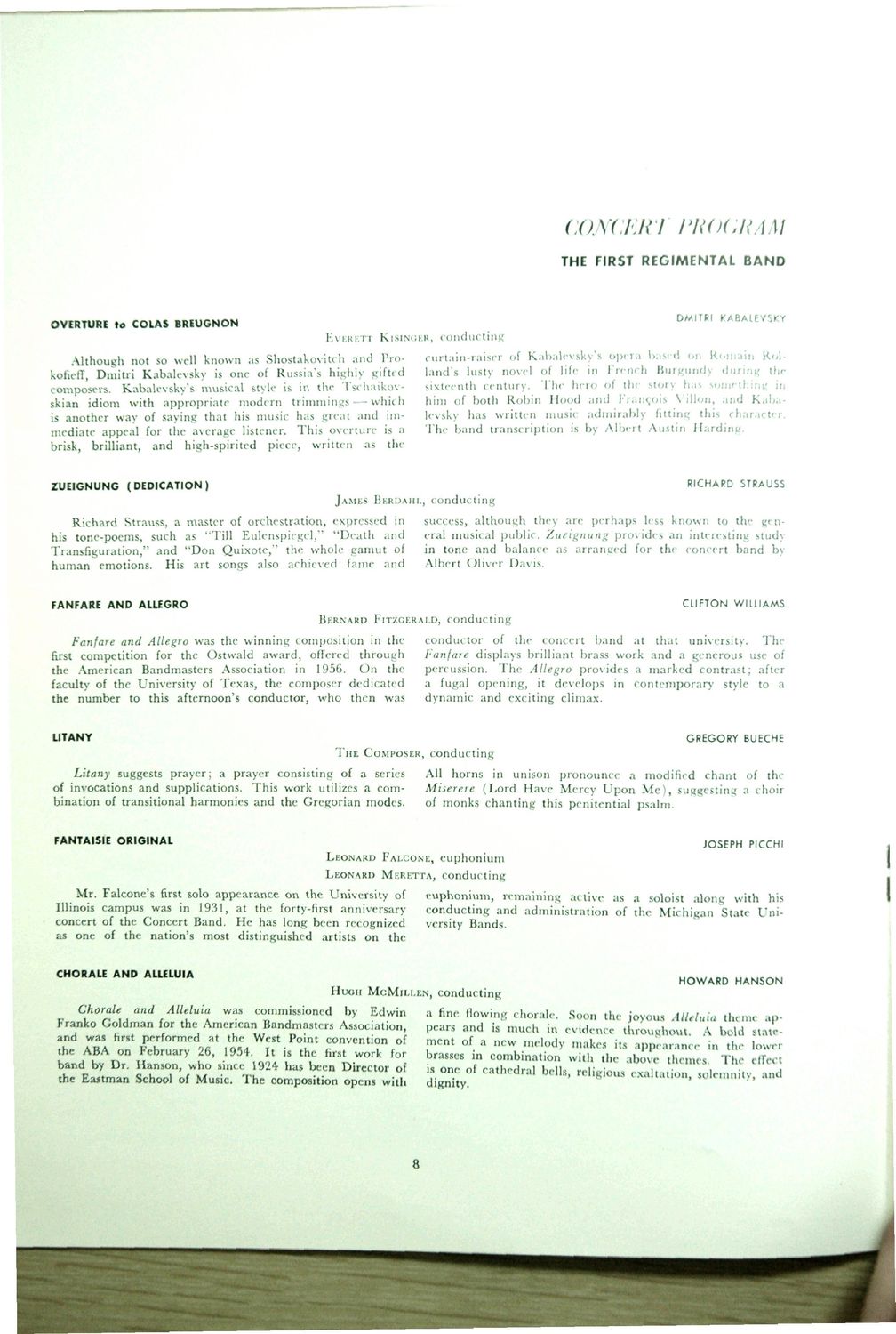Caption: Dedication - Band Building - Band Master's Association
This is a reduced-resolution page image for fast online browsing.

EXTRACTED TEXT FROM PAGE:
CONCERT PROGRAM THE FIRST REGIMENTAL BAND OVERTURE to COLAS BREUGNON EVERETT KISINGER, conducting D M I ™ KABAIEVSKY Although not so well known as Shostakovich and Prokofieff, Dmitri Kabalevsky is one of Russia's highly gifted composers. Kabalcvsky's musical style is in the Tschaikovskian idiom with appropriate modern trimmings — which is another way of saying that his music has great and immediate appeal for the average listener. This overture is a brisk, brilliant, and high-spirited piece, written as the ZUEIGNUNG (DEDICATION) curtain-raiser of Kabalcvsky's opera based on Romain Rolland's lusty novel of life in French Burgundy during the sixteenth century. The hero of the story has something in him of both Robin Hood and Francois Villon, and Kabalevsky has written music admirably fitting this character, The band transcription is by Albert Austin Harding, RICHARD STRAUSS JAMES BERDAHL, conducting Richard Strauss, a master of orchestration, expressed in his tone-poems, such as "Till Eulenspiegel," "Death and Transfiguration," and "Don Quixote," the whole gamut of human emotions. His art songs also achieved fame and FANFARE AND ALLEGRO success, although they are perhaps less known to the genera! musical public. Zueignung provides an interesting study in tone and balance as arranged for the concert band by Albert Oliver Davis. CLIFTON WILLIAMS BERNARD FITZGERALD, conducting Fanfare and Allegro was the winning composition in the first competition for the Ostwald award, offered through the American Bandmasters Association in 1956. On the faculty of the University of Texas, the composer dedicated the number to this afternoon's conductor, who then was LITANY conductor of the concert band at that university. The Fanfare displays brilliant brass work and a generous use of percussion. The Allegro provides a marked contrast; after a fugal opening, it develops in contemporary style to a dynamic and exciting climax. GREGORY BUECHE THE COMPOSER, conducting Litany suggests prayer; a prayer consisting of a series of invocations and supplications. This work utilizes a combination of transitional harmonies and the Gregorian modes. FANTA1SIE ORIGINAL All horns in unison pronounce a modified chant of the Miserere (Lord Have Mercy Upon M e ) , suggesting a choir of monks chanting this penitential psal m. JOSEpH p, C C H , LEONARD FALCONE, euphonium LEONARD MERETTA, conducting Mr. Falcone's first solo appearance on the University of Illinois campus was in 1931, at the forty-first anniversary concert of the Concert Band. He has long been recognized as one of the nation's most distinguished artists on the CHORALE AND ALLELUIA euphonium, remaining active as a soloist along with his conducting and administration of the Michigan State University Bands. HOWARD HANSON HUGH MCMILLEN, conducting Chorale and Alleluia was commissioned by Edwin Franko Goldman for the American Bandmasters Association, and ™ fi"t performed at the: West Point convention of ^ H K n°nM ^ I ' -1954',oJi I u fir8< w o r k f o r band by Dr. Hanson, who since 1924 has been Director of the Eastman School of Music. The composition opens with a fine flowing chorale. Soon the joyous Alleluia theme appears and is much in evidence throughout A bold statcment of a new melody makes its appearance in the lower ^ s s e s * combination with the above themes The effect is one of cathedral bells rrliatn... ™ u - . \ T i *L A & dignity ' * e x a U a t , o n » «>lemmty, and 8
|